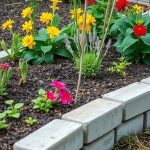Looking to spruce up your outdoor space? Here are 23 alpine garden ideas that bring the charm of the mountains right to your backyard. From unique rock arrangements to vibrant flower beds, you’ll find plenty of inspiration to create your own little slice of paradise.
Creating Rock Gardens with Alpine Plants

Rock gardens are a fantastic way to showcase alpine plants. The image above captures a beautiful scene where various stones create a natural landscape, complemented by stunning green alpine plants. This combination brings a touch of the mountains to your garden.
To start your rock garden, choose a variety of stones. Different sizes and shapes create visual interest. Place larger rocks as focal points and surround them with smaller stones. This layering mimics the natural alpine environment.
When selecting your alpine plants, look for those that thrive in rocky conditions. Succulents and low-growing perennials work perfectly. They not only survive but also add vibrant colors and textures.
A little planning goes a long way. Consider the sunlight and drainage in your space. Most alpine plants prefer well-drained soil and plenty of sunlight. Create small pockets of soil among the stones for planting.
Finally, adding some gravel or sand around the plants will enhance drainage and give the garden a polished look. This simple setup makes for a low-maintenance yet beautiful garden that can be enjoyed throughout the seasons.
Designing a Miniature Alpine Landscape
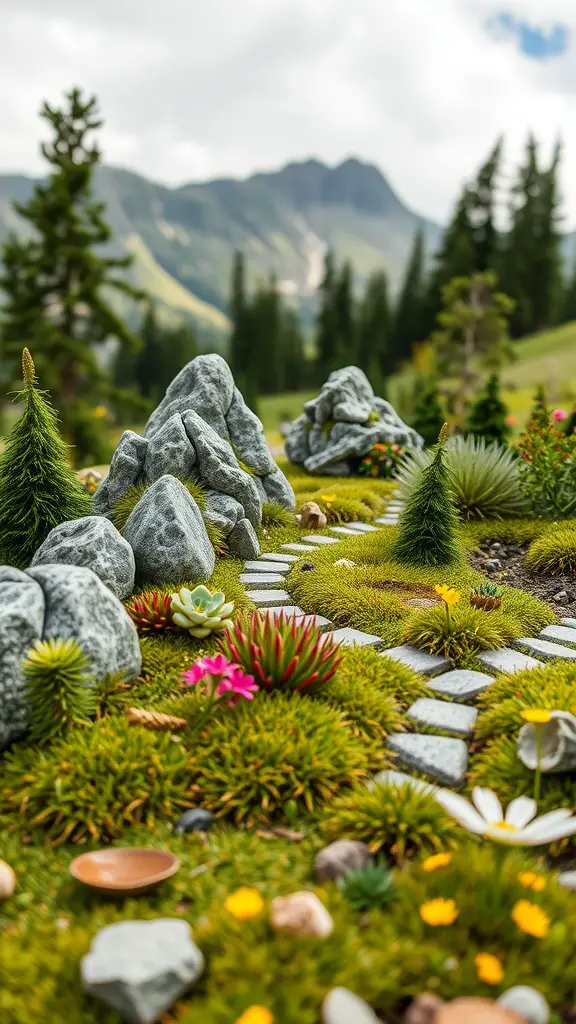
Creating a miniature alpine landscape is a fun and rewarding project. This small-scale design captures the essence of a stunning alpine scenery, complete with rocks, plants, and pathways.
The image showcases a beautiful arrangement of rocks and a winding path leading through lush greenery. The colorful flowers add a lively touch, while the varied textures of the plants mimic an authentic alpine environment.
Start with a sturdy base and arrange larger rocks to form a natural backdrop. Use smaller stones to create a charming pathway. Add a variety of alpine plants such as succulents and colorful flowers to bring the scene to life.
Don’t forget to incorporate some ground cover, like moss or low-growing plants, to fill in gaps. This not only looks appealing but also gives the miniature landscape a realistic feel. It’s all about layering and using a mix of colors and shapes.
Utilizing Container Gardening for Alpine Varieties

Container gardening is a fantastic way to showcase alpine plants, especially if you have limited space. The image shows a vibrant array of alpine varieties in various pots. Each container is filled with different plants, creating a lively visual display.
Alpine plants thrive in well-drained soil, making them perfect for containers. You can easily control the soil quality, moisture levels, and even move the pots to capture the best sunlight. In the image, you can see colorful succulents and flowering plants that illustrate how appealing a container garden can be.
Mixing different types of alpine plants can add texture and color to your space. Notice how the tall cactus contrasts nicely with the shorter, round plants. This variety not only looks good but can also fit different gardening needs. Plus, potting them allows you to create your unique alpine landscape right at home.
Don’t forget to choose containers that suit your style. Just like in the image, you can opt for different shapes and colors to enhance your garden’s appeal. Experimentation is key to finding what works best for you and your space.
Integrating Succulents into Alpine Designs
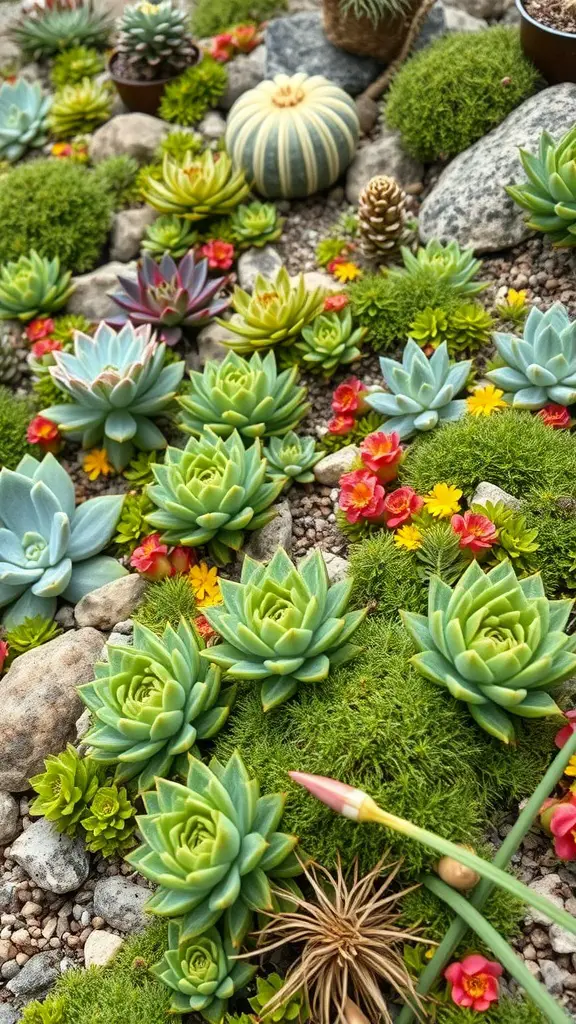
Succulents are a fantastic choice for alpine gardens. They thrive in rocky, well-drained soil, making them perfect for this landscape style. The image shows a beautiful arrangement of various succulents, surrounded by stones and vibrant flowers. This combination creates a lively scene, perfect for any garden.
Incorporating different sizes and shapes of succulents adds interest. The rich greens and unique textures of these plants stand out against the earthy tones of the stones. Pairing them with colorful flowers enhances the overall look and fosters a cheerful atmosphere.
Ground covers like moss and low-growing plants complement the succulents beautifully. They help create a natural feel and also retain moisture in the soil. This balance makes for a stunning alpine garden that is both practical and visually appealing.
Choosing the Right Soil for Alpine Plants
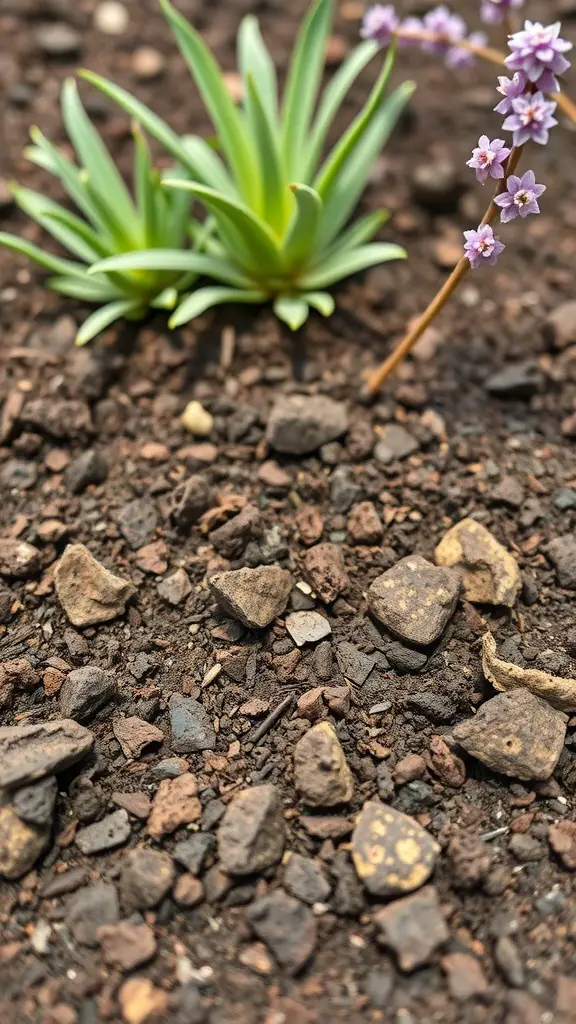
When it comes to alpine gardening, the right soil is key to success. The image shows a textured surface with a mix of small stones and dark earth, perfect for these hardy plants. Alpine plants thrive in well-draining soil that mimics their natural mountainous habitats.
Many alpine plants grow in rocky, sandy conditions. This soil mix allows water to drain quickly, preventing root rot. It’s important to choose a soil that is not too rich; alpine plants prefer lean conditions. A blend of potting soil mixed with sand and gravel can create a suitable environment.
In the image, you can see green foliage and delicate flowers peeking through the rocky surface. This illustrates how alpine plants can add beauty while thriving in less-than-ideal soil. To recreate this look in your garden, aim for a mix that allows your plants to breathe and flourish.
For added nutrients, consider incorporating some organic matter, but keep it light. The goal is to create a balance that supports growth without overwhelming these unique plants. With the right soil, your alpine garden can be a stunning centerpiece.
Incorporating Water Features in Alpine Gardens
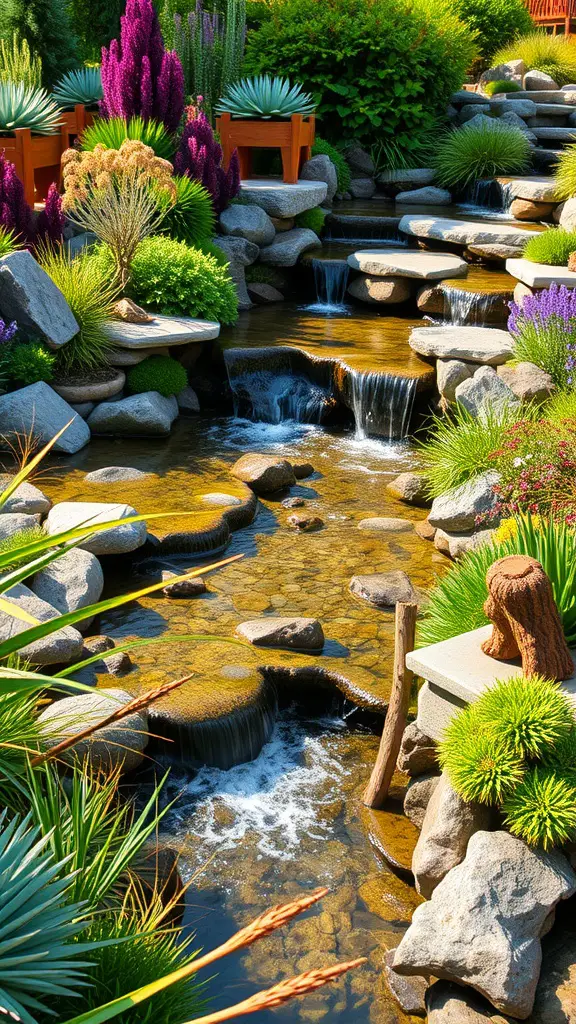
Water features can transform an alpine garden into a serene retreat. Imagine a gentle stream flowing through your garden, bringing life and movement to the landscape. This image showcases a beautiful waterway surrounded by lush plants and striking stones.
The cascading water creates a soothing sound that enhances the natural beauty of the garden. It invites both wildlife and garden lovers alike, making it a vibrant spot in any yard. The mix of textures from the rocks and plants adds depth and interest.
Consider using rocks of varying sizes to create a natural look. These can form steps or terraces that lead to small waterfalls or ponds. Not only do they provide aesthetic appeal, but they also promote biodiversity by attracting birds and beneficial insects.
Another option is to add seating areas near the water. This encourages people to relax and enjoy the calming effects of flowing water. Pairing lush greenery with colorful flowers, as seen in the image, creates a stunning contrast that can uplift any outdoor space.
Creating Pathways with Stones and Gravel

When setting up an alpine garden, pathways play a key role. They guide visitors through the beauty of your plants and rocks, making the experience enjoyable. Using stones and gravel for pathways not only looks great but also offers practical benefits.
The image captures a lovely pathway lined with colorful flowers and natural stones. This design invites you to stroll along and enjoy the scenery. The stones create a firm walking surface, while the gravel fills in the gaps, giving a neat and tidy look. The flowers add a splash of color, making the path even more inviting.
Consider varying the sizes and shapes of stones to make your pathway unique. You can arrange them in a pattern or let them flow naturally. Don’t forget to plant flowers along the edges. This adds charm and draws the eye along the path. A pathway like this not only serves a functional purpose but also enhances the overall beauty of your alpine garden.
Selecting Hardy Alpine Flowers for Year-Round Interest
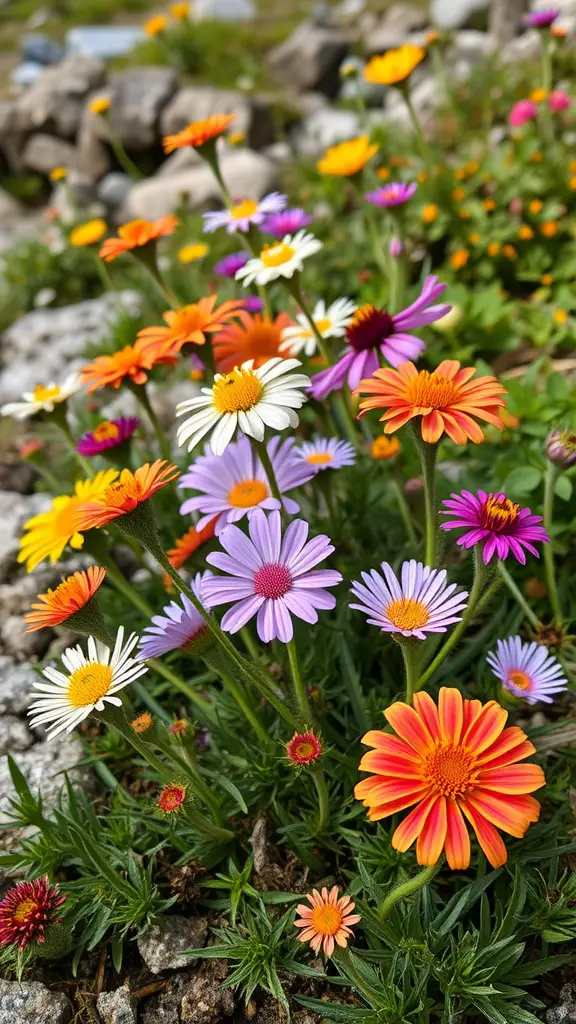
When creating an alpine garden, choosing hardy flowers is key. These vibrant beauties can thrive in tough conditions, bringing color and life to rocky landscapes.
The image shows a lively mix of alpine flowers, displaying shades of orange, white, purple, and pink. These colors brighten any garden, especially in cooler climates.
Consider species like the alpine daisy or the hardy geranium, known for their resilience. They bloom in spring and can add charm throughout the seasons. This blend of colors creates a cheerful atmosphere, making your garden a delightful place to relax.
Make sure to plant them in well-drained soil and give them some sunlight. Their ability to flourish despite harsh conditions is what makes them so appealing for alpine garden setups.
Building Terraces for Elevation in Alpine Gardens
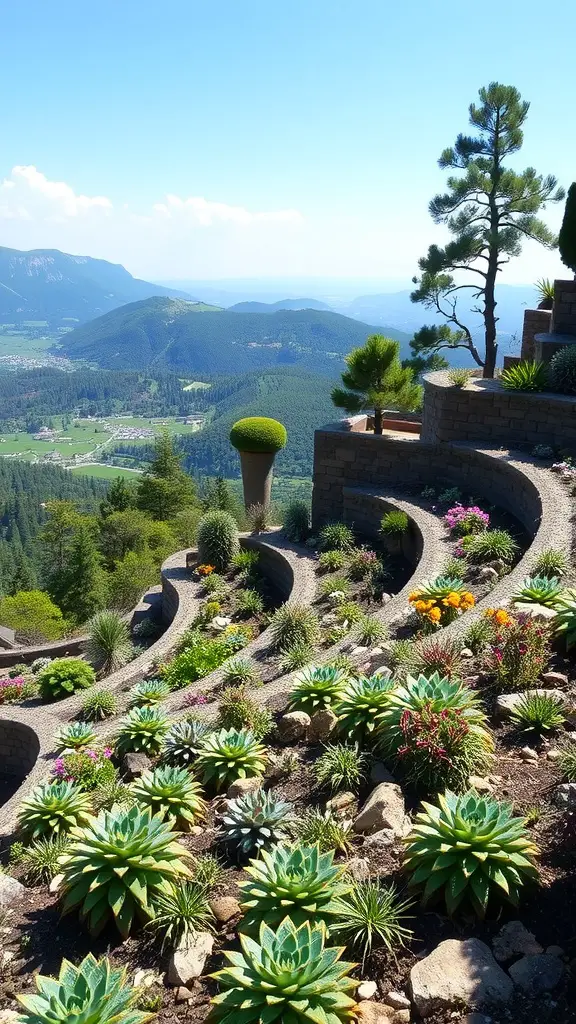
Terracing is a wonderful way to create elevation in alpine gardens. The image showcases a beautifully designed terrace that slopes gracefully down the landscape. This approach not only looks stunning but also helps manage water drainage, which is vital in mountainous regions.
Each level of the terrace is filled with a variety of plants, including vibrant flowers and lush succulents. These plants are well-suited for alpine conditions, offering color and texture that enhance the overall design. The curved pathways add a soft touch, making the garden feel inviting.
Incorporating different plant heights and types on each terrace creates visual interest. This method allows gardeners to play with layers and contrasts, highlighting the natural beauty of the plants. The use of rocks and stones adds stability and complements the surrounding environment.
With proper planning, creating terraces in an alpine garden can be a satisfying project. It fosters a connection between the garden and the stunning mountain views, making it a perfect spot for relaxation and appreciation of nature.
Creating a Themed Alpine Garden
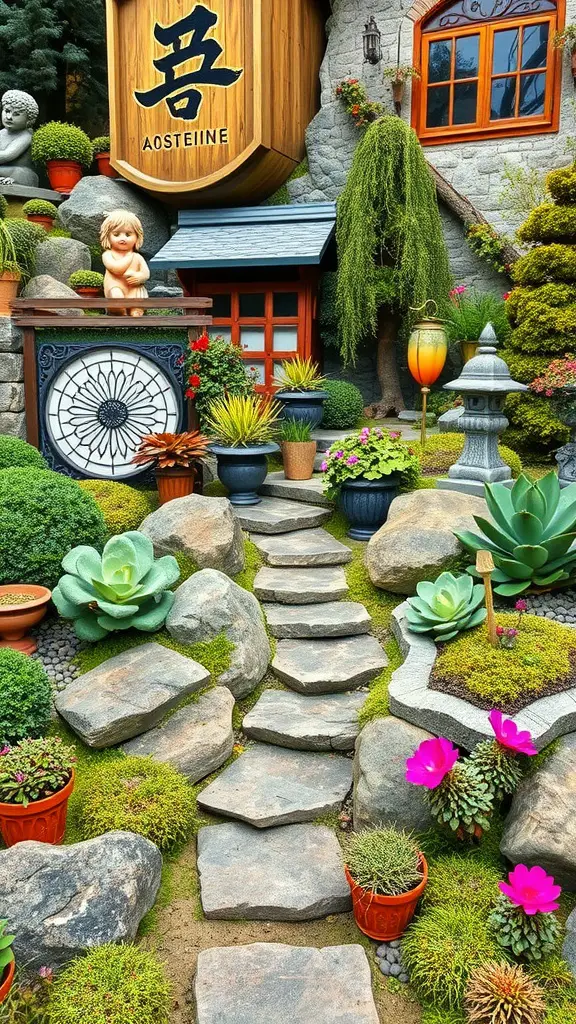
Creating a themed alpine garden can bring a unique touch to your outdoor space. The image showcases a charming setup featuring a variety of plants and decorative elements. Notice the carefully arranged stones and vibrant flowers, which create a welcoming path through the garden.
The use of different textures and colors adds depth. The stone statues and lantern provide a sense of character, making it feel like a serene retreat. Incorporating various plant types, such as succulents and colorful blooms, enhances the visual appeal while making maintenance easier.
Choosing a theme, like a Japanese-inspired alpine garden, can elevate your design. Elements like a small water feature or decorative rocks can reflect tranquility. This approach encourages relaxation and enjoyment of nature’s beauty right at home.
Adding Texture with Alpine Grasses

Alpine grasses bring a unique touch to garden designs. Their tall, feathery plumes add height and movement, creating a dynamic look in any space. The grasses in the image showcase a lovely golden hue that catches the sunlight, enhancing the overall feel of the garden.
Using these grasses in your garden can break up monotony. They contrast beautifully with other hardy plants and rocks, making them perfect for alpine gardens. Imagine walking through a garden where the grasses sway gently in the breeze—it’s a sight to behold!
For a successful alpine garden, consider clustering these grasses. This not only emphasizes their texture but also allows them to stand out against lower-growing plants. Incorporating various sizes and colors can create layers of interest, appealing to anyone who visits your garden.
Utilizing Native Plants for Sustainable Alpine Gardening
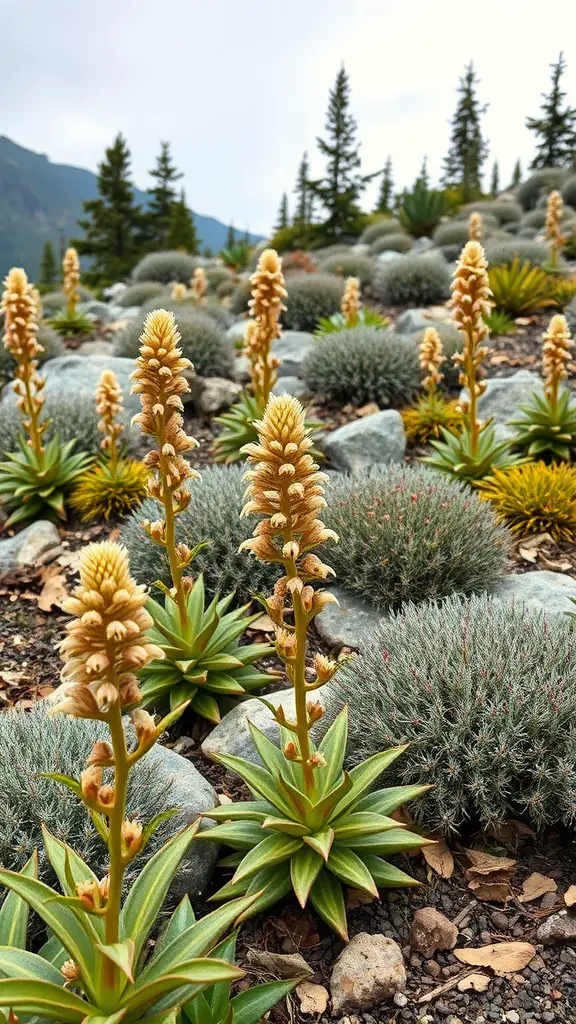
Native plants are the backbone of any sustainable alpine garden. They adapt easily to local conditions, requiring less water and care. In the image, a variety of native alpine plants flourish in a rocky landscape. Their unique shapes and colors create a stunning visual contrast against the rugged backdrop.
These plants not only thrive in challenging environments but also support local wildlife. Pollinators like bees and butterflies are drawn to their natural beauty, making your garden a mini-ecosystem. In the picture, you can see how these plants interact with their surroundings, blending beautifully with the rocky terrain and other flora.
Choosing native species reduces the need for chemical fertilizers and pesticides, promoting a healthier garden. The plants displayed here highlight how well they can flourish in harmony with nature. Their resilience is impressive, showcasing the strength of native flora.
So, when planning your alpine garden, look to your local native plants. They will not only help the environment but also offer a low-maintenance solution for a beautiful garden.
Planning Seasonal Blooms for Continuous Color

Creating an alpine garden is a great way to enjoy vibrant colors throughout the seasons. Imagine stepping into a space bursting with colorful flowers, like those seen in the image above. The blend of pinks, yellows, and whites showcases how well seasonal blooms can work together.
To achieve this look, think about selecting plants that bloom at different times. Early spring brings tulips and daffodils, while summer can showcase daisies and asters. In fall, consider adding chrysanthemums to keep the colors alive as the year winds down.
The use of rocks in the garden adds texture and helps with drainage, which many alpine plants prefer. Planting in layers can also create a stunning visual effect. This arrangement not only looks appealing but also allows for easy maintenance.
Continuous color is all about planning. Keep track of when each plant blooms and fill in gaps with annuals if needed. This way, your garden can remain lively and inviting no matter the season.
Incorporating Edible Alpine Plants
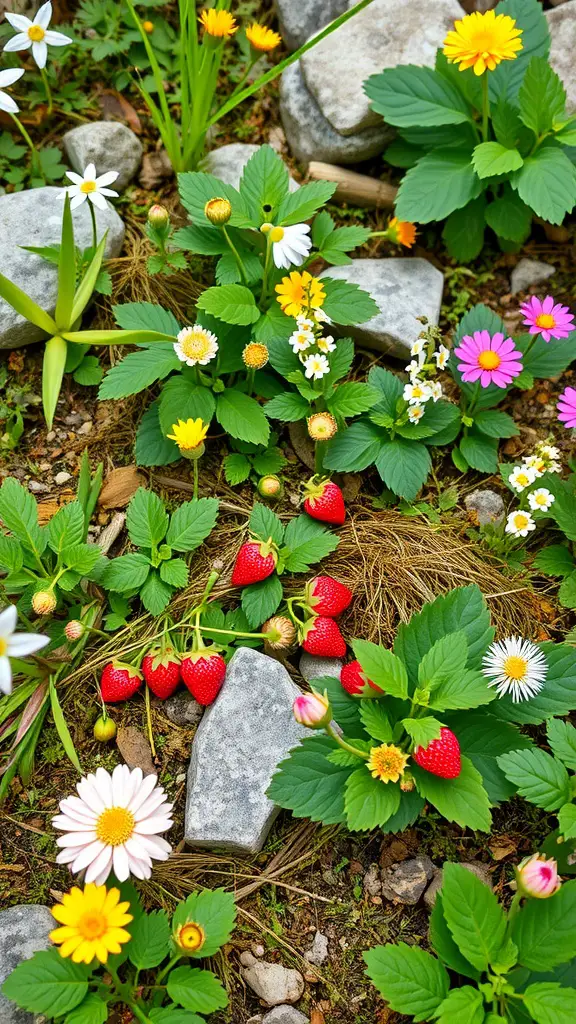
Incorporating edible alpine plants into your garden can be a delightful way to blend beauty with function. The image showcases a vibrant alpine garden filled with colorful flowers and ripe strawberries. These plants not only brighten up your space but also provide tasty treats right from your backyard.
Alpine strawberries, featured prominently in the image, are a fantastic choice for gardens with limited space. They thrive in rocky, well-drained soil and produce sweet, small berries that are perfect for snacking or adding to desserts. Pair them with cheerful flowers like daisies and buttercups to create a visually appealing arrangement.
Consider planting herbs like alpine thyme or chives alongside your flowers for added flavor and utility. These plants generally require similar care, making them easy to manage together. Plus, they can enhance your culinary dishes with fresh, homegrown ingredients.
When planning your alpine garden, think about the layout. Using natural stones as borders or pathways can give the area a rustic feel while helping with drainage. Mixing in different heights and colors will make your garden visually interesting and inviting.
Utilizing Vertical Gardening Techniques in Alpine Settings

Vertical gardening is a fantastic way to make the most of limited space, especially in alpine gardens. Imagine a vertical wall brimming with lush greenery and vibrant flowers. The image showcases a stunning example of this concept, with cascading plants that create a living tapestry against a wooden backdrop, blending beautifully with the natural surroundings.
This setup not only adds a pop of color but also maximizes the vertical space of your garden. Using pots and hanging planters, you can cultivate different types of alpine plants that thrive in these conditions. The arrangement allows for easy access to plants while making a striking visual statement.
In addition to aesthetics, vertical gardens help with air circulation and can even improve your garden’s overall health. The design enables sunlight to reach all plants, promoting growth and vibrant blooms. Consider incorporating a mix of flowers, ferns, and trailing plants to achieve that lush look while keeping maintenance manageable.
Try using native alpine plants that are well-suited to your climate. They often require less water and care, ensuring your vertical garden remains stunning without too much effort. Whether you have a small balcony or a larger space, vertical gardening can transform it into a charming alpine retreat.




